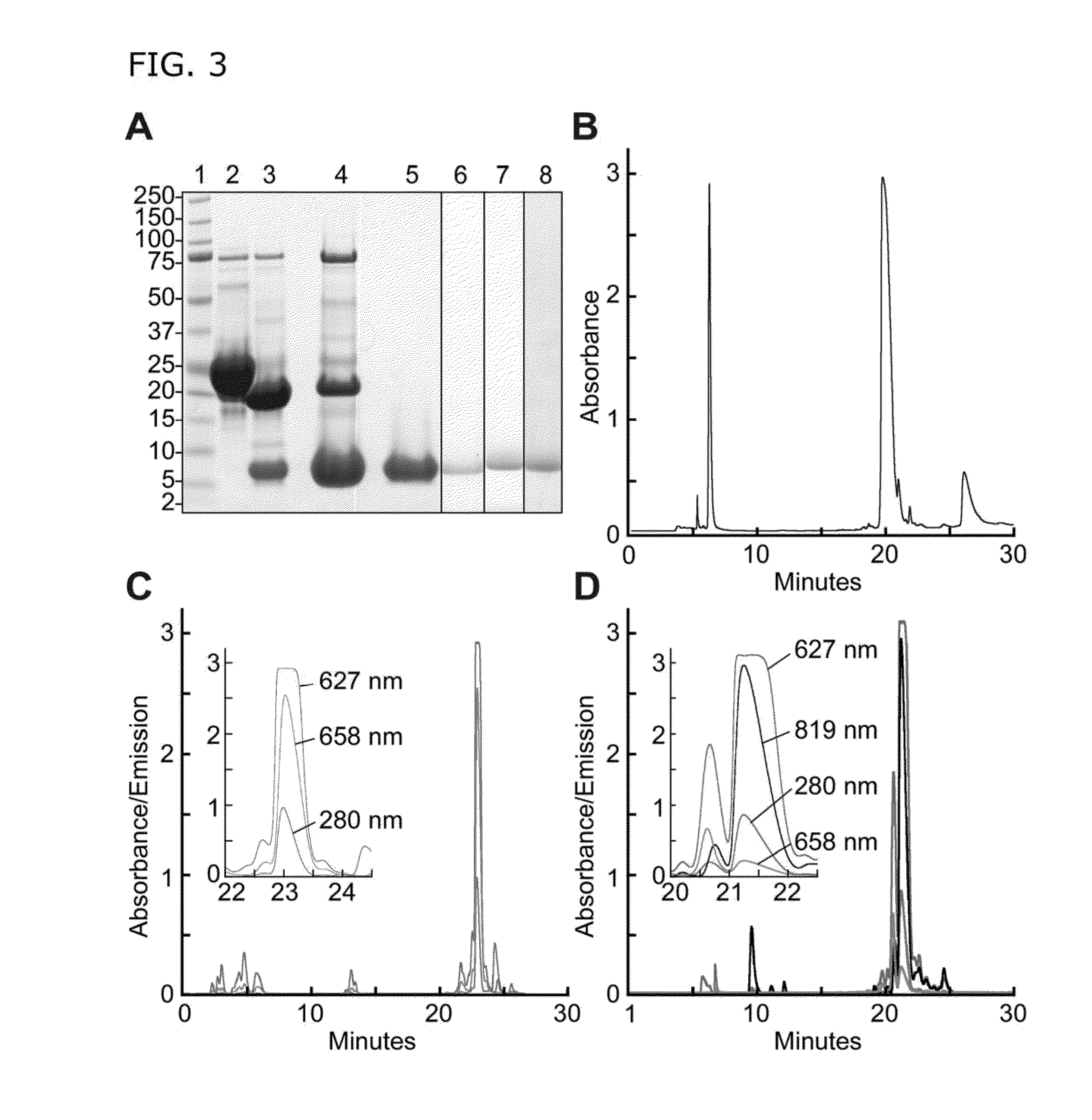Fluorogenic substrate for ADAMTS13
a technology of fluorogenic substrate and adamts13, which is applied in the direction of peptide/protein ingredients, instruments, peptide sources, etc., can solve the problems of insensitivity to inhibitors, difficult automation, chemically synthesized, and high cost of available assays for adamts13 activity, and achieve the effect of increasing the sensitivity of assays for inhibitors of adamts13 activity
- Summary
- Abstract
- Description
- Claims
- Application Information
AI Technical Summary
Benefits of technology
Problems solved by technology
Method used
Image
Examples
example 1
[0143]This example illustrates a substrate oligopeptide.
[0144]The inventors designed a chimeric construct in plasmid pET-32 Xa / LIC (Novagen, Billerica, Mass.) encoding an N-terminal His-tag, thioredoxin, Tobacco Etch Virus (TEV) protease cleavage site, a Gly residue, and VWF (Gln1599-Arg1668). Two mutations were made in the VWF segment: N1610C introduced a thiol group for alkylation, and K1617R removed an amino group that competes with the peptide N-terminus for chemical modification. This oligopeptide was expressed in IPTG-induced BL21 cells, purified on Ni-NTA-agarose, and digested with His-tagged TEV protease (made by the present inventors). TEV protease and thioredoxin were removed on Ni-NTA-agarose, and the C-terminal peptide (FIG. 1) was purified by C18 reverse phase HPLC. >100 mg of this peptide was prepared, sufficient for thousands of assays.
[0145]In FIG. 1, the scissile Y-M bend is indicated (triangle) and the C-terminal segment of VWF domain A2 which can promote efficient...
example 2
[0146]This example illustrates fluorescence donors and quenchers.
[0147]The present inventors have tested several combinations of donor and quencher groups chosen for lack of interference from blood proteins. For example, modification at Cys1610 with Alexa Fluor 594 maleimide (abs 590 nm, em 617 nm, ε 96,000) and at N-terminal. Gly with QSY21-succinimidyl ester (abs 661 nm, ε 90,000) gave superior fluorescence quenching and sensitivity compared to FRETS-VWF73, but this substrate had poor solubility. In one embodiment, a substrate of the present teachings is modified at Cys1610 with DyLight 633-maleimide (Thermo, abs 638 nm, em 658 nm, ε 170,000), and at N-terminal Gly with IRDye QC-1 N-hydroxysuccinimidyl ester (LI-COR, abs 737 nm, ε 96,000). These dyes incorporate sulfate groups and have markedly increased water solubility. After RP-HPLC purification the doubly-labeled substrate (FRETS-rVWF71) is soluble at >50 μM. These dyes absorb / emit in the near-infrared, which does not overlap ...
example 3
[0148]This example illustrates ADAMTS13 activity assays.
[0149]Preliminary studies show that paired samples of citrated plasma and serum have the same ADAMTS13 activity, which is stable for extended times at 4° C. or −20° C. These findings are consistent with published data (Gerritsen, H. E., et al., Blood. 98:1654-1661, 2001; Furlan, M., et al., Blood. 87:4223-4234, 1996).
[0150]In these experiments, the FRETS-rVWF71 substrate was utilized in a microtiter format (FIG. 2), which is compatible with fluorescence plate readers that are supported by laboratory equipment suppliers and available in many clinical hemostasis laboratories, such as the BIO-TEK FLx800 Fluorometer from DiaPharma (West Chester, Ohio) or Technoclone (Vienna). Reactions were performed in 200 μL 5 mM Bis-Tris, pH 6, 25 mM CaCl2, at room temperature with added plasma as shown (FIG. 2). Fluorescence was monitored in a Victor2 V microplate reader (Perkin Elmer Life Sciences, Boston, Mass.) with 638 nm excitation filter ...
PUM
| Property | Measurement | Unit |
|---|---|---|
| volume | aaaaa | aaaaa |
| pH | aaaaa | aaaaa |
| pH | aaaaa | aaaaa |
Abstract
Description
Claims
Application Information
 Login to View More
Login to View More - R&D
- Intellectual Property
- Life Sciences
- Materials
- Tech Scout
- Unparalleled Data Quality
- Higher Quality Content
- 60% Fewer Hallucinations
Browse by: Latest US Patents, China's latest patents, Technical Efficacy Thesaurus, Application Domain, Technology Topic, Popular Technical Reports.
© 2025 PatSnap. All rights reserved.Legal|Privacy policy|Modern Slavery Act Transparency Statement|Sitemap|About US| Contact US: help@patsnap.com



